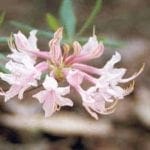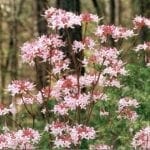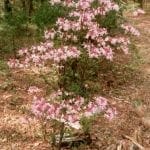- Flowers
- Flowers
- Habit
- Habit
- Habit
The piedmont azalea (Rhododendron canescens) is a hallmark of spring in Georgia: delicate, light pink blossoms dancing at the woodland’s edge to celebrate the change of the seasons. Southeastern gardeners can also readily employ the charms of this native shrub in the home landscape, so it’s no wonder the Georgia Native Plant Society selected it as its 2001 Plant of the Year.
This native beauty is widespread throughout the Southeast and is found not only in the Piedmont (as its name might imply), but also in the mountains and coastal plain, and it thrives in USDA Hardiness Zones 6 through 9. It is most often found in deciduous woodlands where it receives ample sun in late winter and early spring, but is shaded from the hot sun of summer. It prefers a rich, moist, but well drained soil, and, as with other species in the Rhododendron genus, it prefers acidic conditions.
The piedmont azalea grows in an open and graceful, upright habit, usually from 5 to 10 feet in height. Its shallow roots are stoloniferous, often creating large colonies of the shrub. The blooms appear in early spring, usually before the leaves begin to unfurl. Bloom color is quite variable, especially since there is much natural hybridizing among native azaleas, and the hue may range from white to light pink to deep rose. The trumpet-shaped flowers are borne in clusters, and their grace is accentuated by long, delicate, curving stamens. The blossoms gently perfume the air with a delightfully sweet fragrance. Adding to their enchantment are the numerous butterflies, hummingbirds, and bees the flowers attract.
To make one of these beauties happy in your garden, aim to duplicate its natural growing conditions. Select a location with enough sun to encourage blooms, but with protection from the hot, glaring afternoon sun. Give it a moist, but well drained acidic soil that is rich in organic material. Mulch with pine straw or pine bark to help conserve soil moisture and protect the shallow roots. Take care to keep your newly planted azalea well watered until it is firmly established. Beyond that, it will need little maintenance. Prune only if you want to encourage especially dense growth, and apply only a light application of fertilizer in early spring. The piedmont azalea makes a superb addition to a garden at woods’ edge and harmonizes well with other spring-blooming natives, such as woodland Phlox (Phlox divaricata), foamflower (Tiarella cordifolia), and mayapple (Podophyllum peltatum). Whether you enjoy its beauty domesticated in the garden or wild in the woods, you are sure to agree that the piedmont azalea is a winner.
Prepared by Mary Pyne Tucker for the Georgia Native Plant Society.
Scientific Name:
Common Name:
Scientific Name Pronounciation:
Plant Type:
Shrub
Plant Hardiness Zones:
Plant Hardiness Zone(s):
Usual Size:
Flower:
Bloom Time Notes:
Leaf:
Fruit:
Wildlife:
Natural Habitat:
Propagation:
Bloom Time:
Sun or Shade:
Companion Plants:
Cultural Notes:






